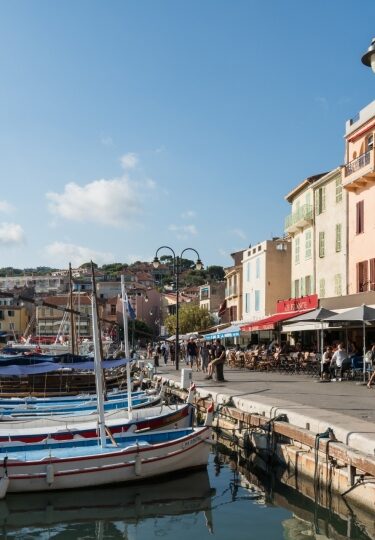The best small towns in France share a certain timelessness with their cobbled squares, painted shutters, and inviting markets. Beautiful rural and coastal towns are to be found all over the country, from the lavender fields of Provence to the rolling vineyards around Bordeaux, and under the big skies of Normandy in the north.
A key element of these special French towns is how they blend in so organically with their surroundings. They’re typically found in areas of particular scenic beauty, with the surrounding landscape enhancing the town—and vice versa.
Read on for a list of ten small towns in France that offer architectural elegance, historic intrigue, and winding lanes fragranced by freshly baked croissants.
Villefranche-sur-Mer
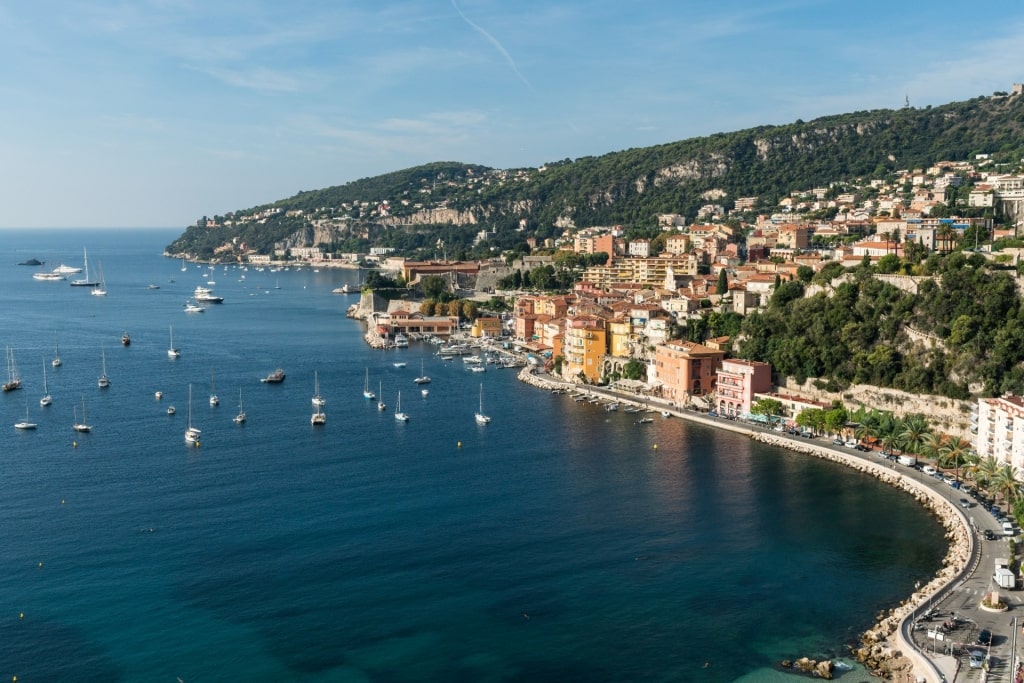
Villefranche-sur-Mer
A coastal town and deepwater port found on the Cote d’Azur, Villefranche-sur-Mer may today be counted as a suburb of glitzy Nice, but it very much retains its own character.
Just the other side of Mont Boron from Nice, the pastel-colored, broad-chested buildings of the old town are arranged in tiers up the verdant incline.
Beneath their shuttered gaze, families linger on the wide pebbled beach while in the deeply curving bay, brightly painted pointu fishing boats bob on the wakes of passing superyachts.
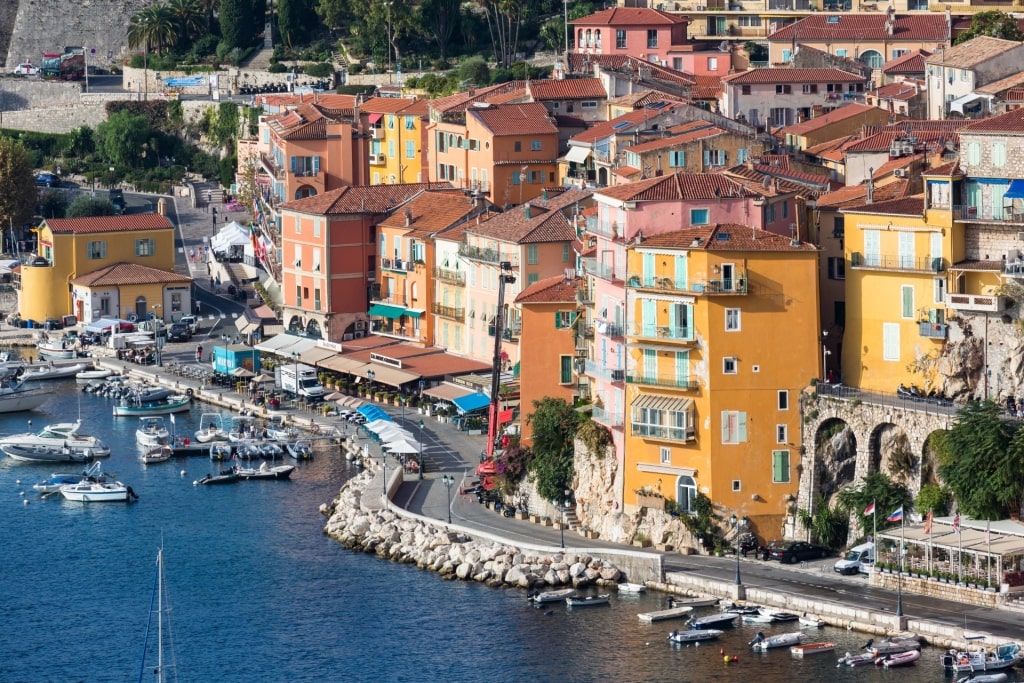
Villefranche-sur-Mer
The old town is a maze of palm-shaded stone streets. You’ll happen across alleys lined with bistro tables draped in checkered cloth, or wedges of sunlit space within which market stalls are arranged in a colorful cluster.
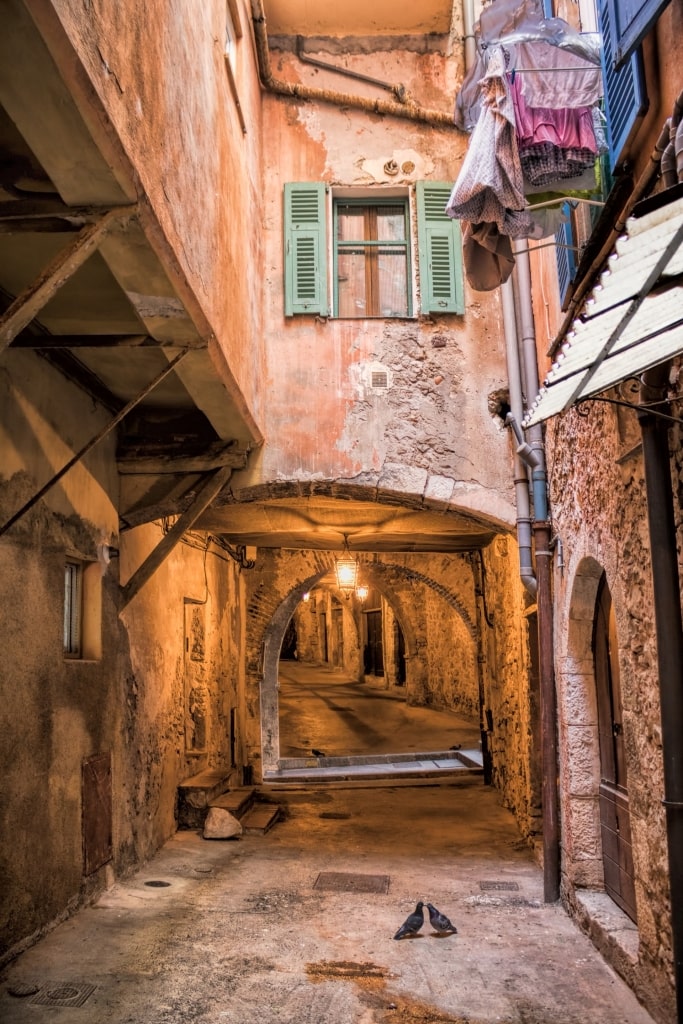
Rue Obscure, Villefranche-sur-Mer
While history is all around you, it gathers more densely in the 13th-century Rue Obscure—an underground passageway that runs beneath the harborfront houses—and in the Sainte-Elme citadel.
Villefranche is unlike some Côte d’Azur towns in that a visit to its citadel doesn’t involve an exhausting ascent (although the views of Cap Ferrat and the Cape of Nice from the higher altitudes are lovely).
Sited close by the harbor, the 16th-century fortress has gardens lit with Mediterranean color as well as maritime museums housed beneath the arches of its modernized interior.

Plage des Marinières, Villefranche-sur-Mer
Inevitably, you’ll be drawn to dip your feet in the clear waters lapping Plage des Marinières’ finely pebbled shores. You’ll find bars and restaurants nearby. Head to the east end of this French Riviera beach if you want more space.
Read: Best Beaches in Nice
Èze

Èze
Hovering above the southern French coastline, Èze is one of the small towns in France that tends to make most visitors’ bucket lists.
On a hilltop between Nice and Monaco, Èze is a delight to explore. While wandering amid the worn stone archways and heavy wooden doors framed with mauve wisteria, your eye will be drawn to the incredible views of inland olive groves and vines, and the shimmering blue of the Mediterranean.

Èze
Among the streets of this carefully coiled outpost of traditional Provence, there are a number of stone benches, well-situated café terraces, and a botanical garden at which to rest your step-weary calves.

Fragonard Perfume Factory, Èze
The latter is lovely, set over three levels, with towering fingers of cactus and colorful succulents vivid beneath the Provençal sun. If you’d rather seek some shade, find the scented sanctuary of the Fragonard Perfume Factory for a guided tour.
Far below the medieval walls of Èze—maybe while having a glass of chilled rose wine at Le Bar on Rue de Barri—you’ll see a glint of bright turquoise. This is the line of loungers arranged on Anjuna Beach.
A celebrity magnet, and always with yachts offshore during summer in France, its private beach club is a favored Monaco Grand Prix after-party destination.
Honfleur
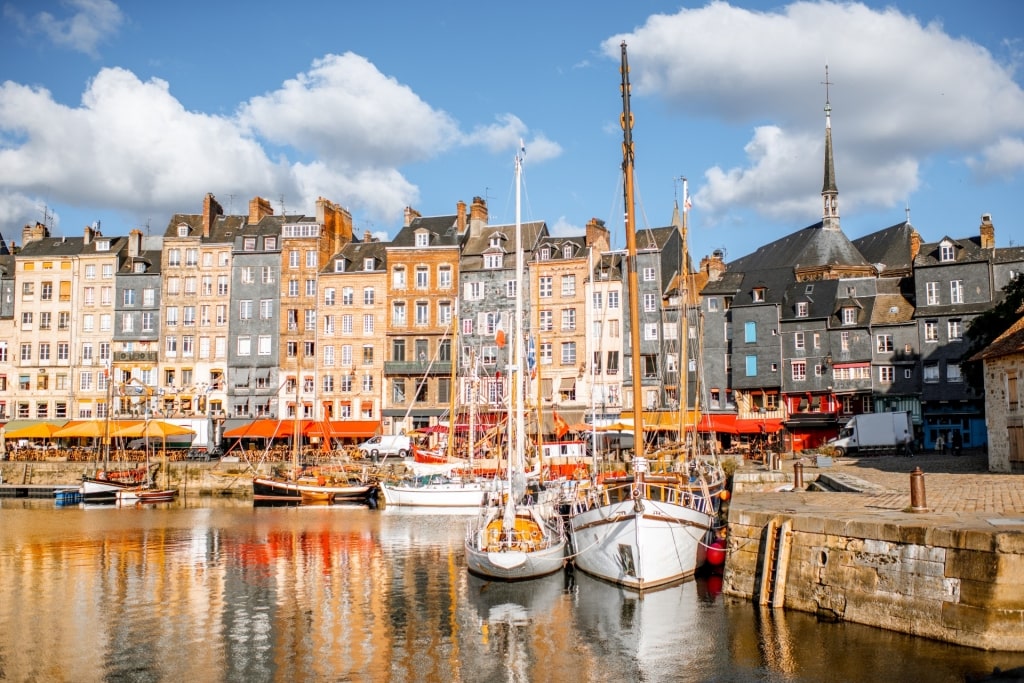
Honfleur
A colorful counterpoint to Normandy’s heavyweight military history, Honfleur is one of this northern region’s most instantly recognizable destinations.
Situated on the Seine estuary, Honfleur is best known for the colorful ribbon of half-timbered townhouses encircling its port. The way the light plays over the cream, slate, and cinnamon brown has, naturally, brought the artists flocking to set up their easels.

Eugène Boudin Museum, Honfleur Photo by Jim Linwood on Flickr, licensed under CC BY 2.0
Honfleur is primarily known as an Impressionist haunt. Monet used to paint the port and the estuary from a hill above the town.
The Eugène Boudin Museum, in the backstreets near the port, has a fine collection of art from Monet, among other big names, as well as Boudin himself—a homegrown practitioner of pre-Impressionist technique.
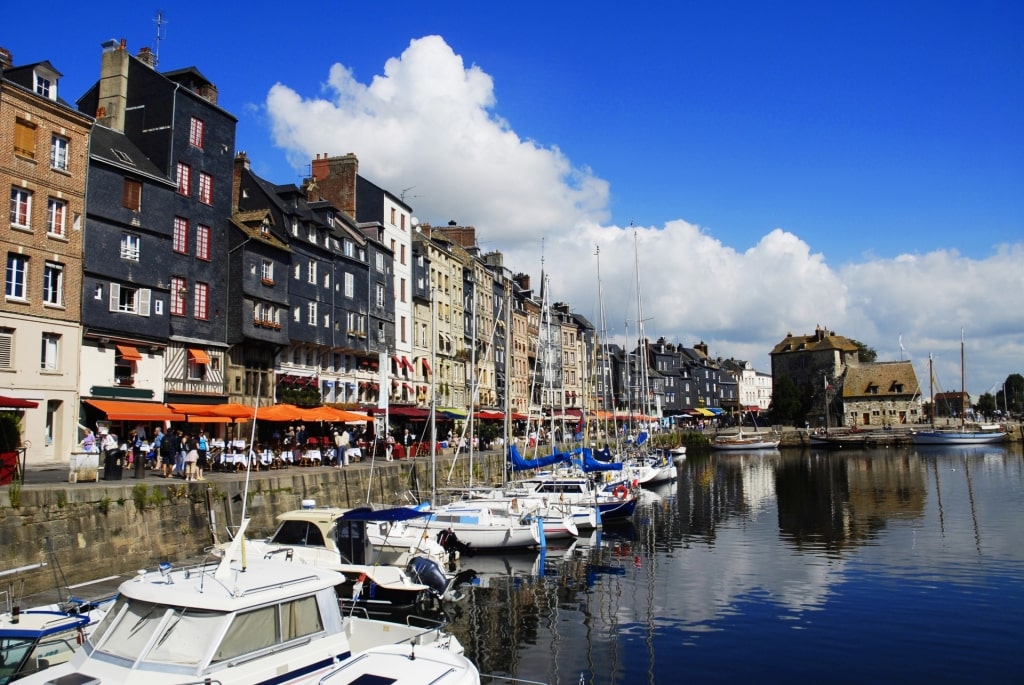
Honfleur
But admiring these different interpretations of the famous Seine estuary light can’t match up to contemplating the real thing.
Find a table at one of the many restaurants lining the Vieux Bassin (or L’Ecailleur for something special), order super fresh moules-frites, and drink it in while listening to the clinking of the masts and the mewing of the gulls.
Cassis
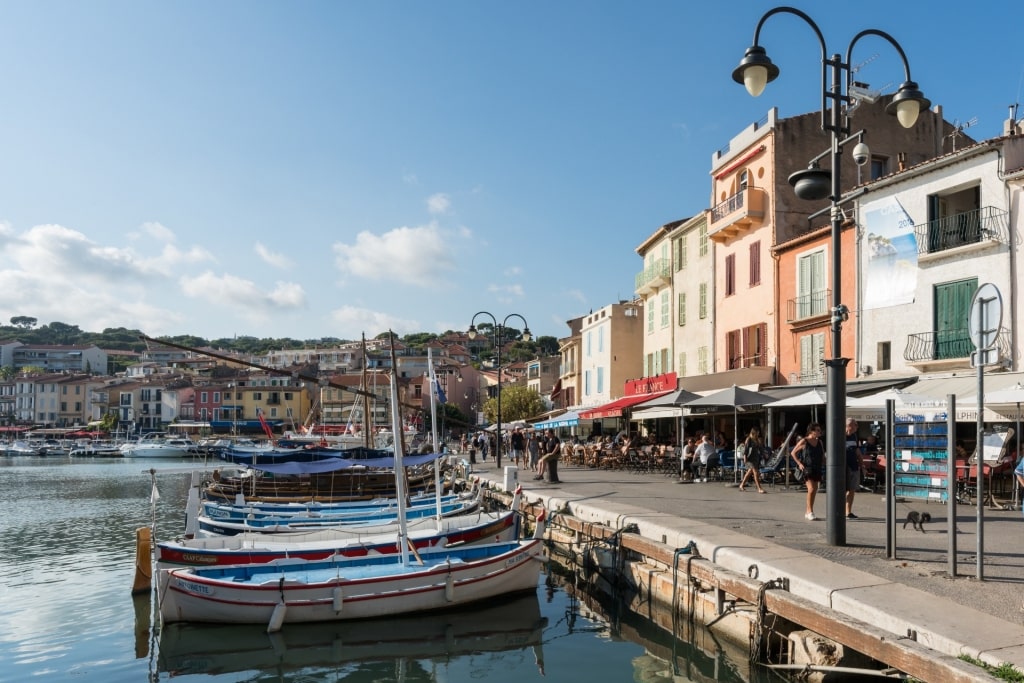
Cassis
Cassis, an exquisite fishing town located east of Marseilles and in the shadow of the imposing Cap Canaille, has been inhabited for over 2,000 years.
While you might not pick up the sense of its ancient history among its sunny 18th and 19th-century houses with their pastel-colored shutters, it’s immediately clear upon arrival that this is one of the most perfect small towns in France.

Kir royale
While you’re admiring the sailboats, tasting at the cheese stall, or peering into the windows of its boutiques, it’s a delicious cliché to find a harborside bar and order a kir royale.
This cocktail blends champagne and the blackcurrant liqueur, crème de cassis (“cassis” means blackcurrant). For the cassis without the alcohol, try Maison Casalini’s blackcurrant sorbet.
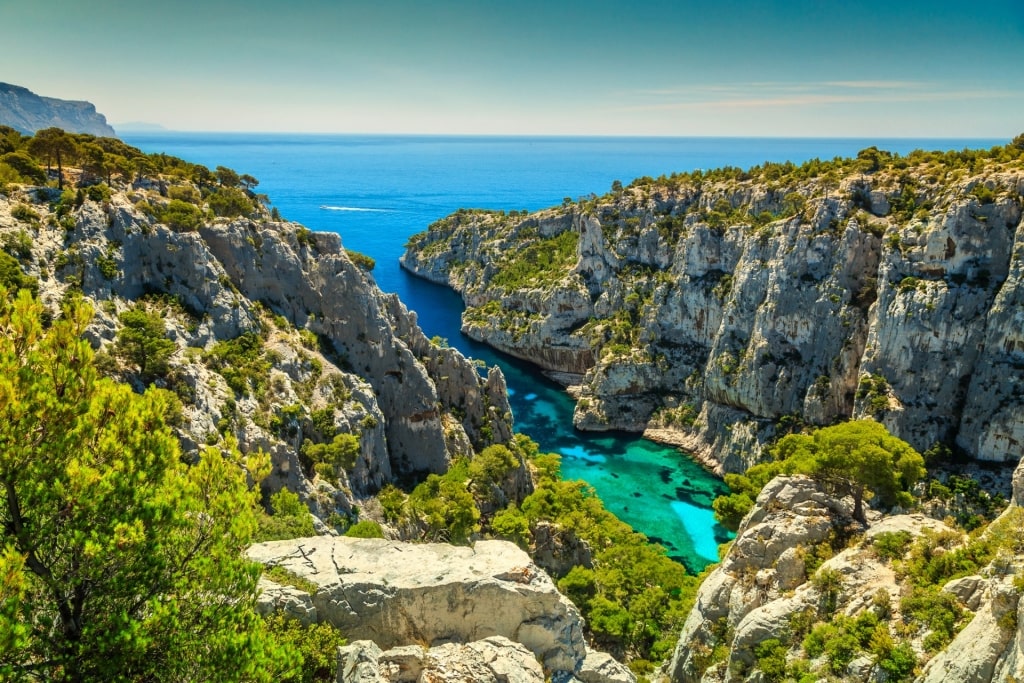
Calanques
Cassis is also known as the gateway to the Calanques—a national park of inlets of near-mythic beauty sheltered beneath craggy, bleached cliffs. A hike or boat trip to cool your feet in the vivid aquamarine waters of these peaceful limestone coves is a must.
Saint-Émilion

Saint-Émilion
One of the most famous sights of Bordeaux is to see the honeyed bell tower of Saint-Émilion rising up from the wine region’s vine-striped fields.
Just under an hour’s drive from the city of Bordeaux, and one of the few UNESCO-listed small towns in France, this medieval pilgrimage destination offers intriguing history, architecture, and world-class wine.

Wine in Saint-Émilion
The appellation (the French name for a designated wine growing area) named for the town is famous for its reds, with the renowned Château Cheval Blanc one of its preeminent producers. Needless to say, there are numerous wine shops in the town, and it’s fun to buy a souvenir bottle, or even a case.
Beyond the wine that France is known for, the small and imperfectly formed squares you’ll wander through are filled with history. But it’s beneath the cobbles that you’ll find the town’s most intriguing structure.

Monolithic Church of Saint-Émilion
The 12th-century underground monolithic church, carved out like a vast wine cellar beneath Saint-Emilion, is where the namesake saint met the pilgrims who sought out his miracles (and maybe a taste of the local wine).
The only way to explore the church is through a guided tour by the tourist office, but a visit here is fascinating.
Read: The Ultimate Bordeaux Wine Region Guide
Aigues-Mortes
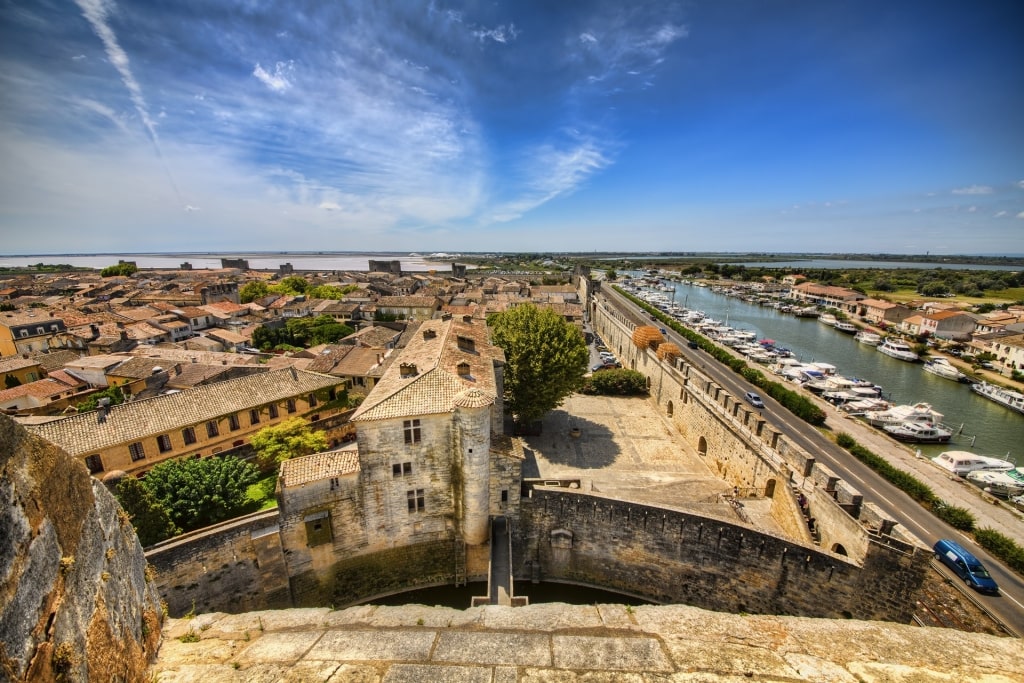
Aigues-Mortes
Aigues-Mortes is a town in the Occitanie, the region adjoining Provence. Its calling card is its fortified wall, which completely encircles this engaging place.
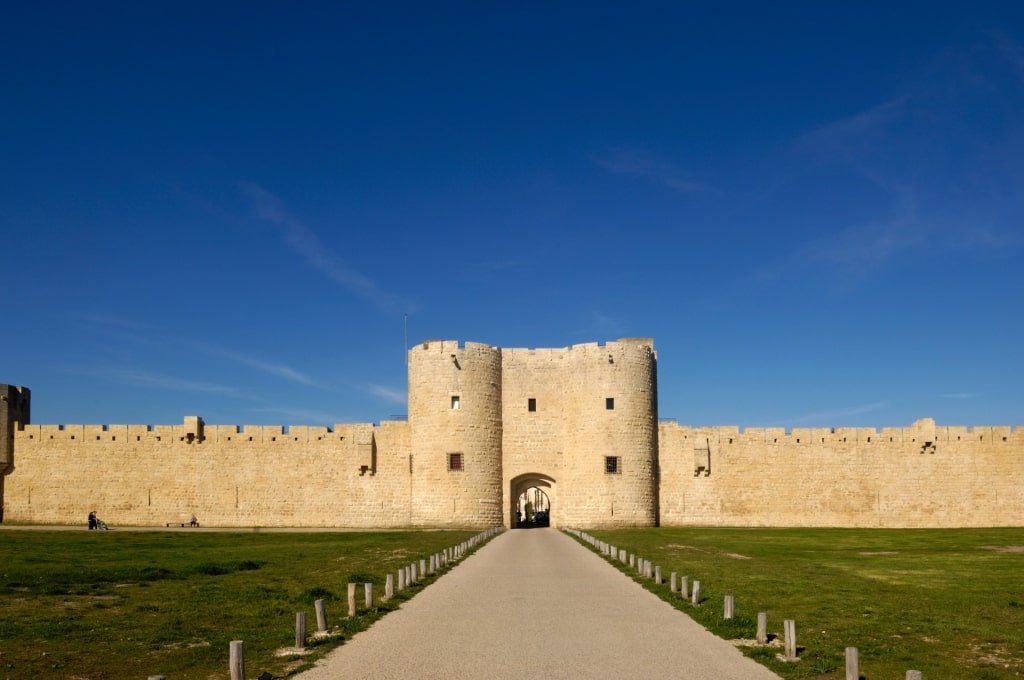
Aigues-Mortes
Walk through one of the ten medieval entrances into the town and it’s noticeable how the wind drops. Feel the breeze again by walking the fortified walls, formerly the protective exterior of a town that was home to Templar Knights. Aigues-Mortes was also a major jumping-off point for the crusades during the reign of Louis IX.
In the evening, the town comes alive with squares crammed with lively bars and shops that sell flamingo shirts and flamingo stuffed toys late into the balmy evening. These niche French souvenirs are related to what surrounds the town—the Camargue.
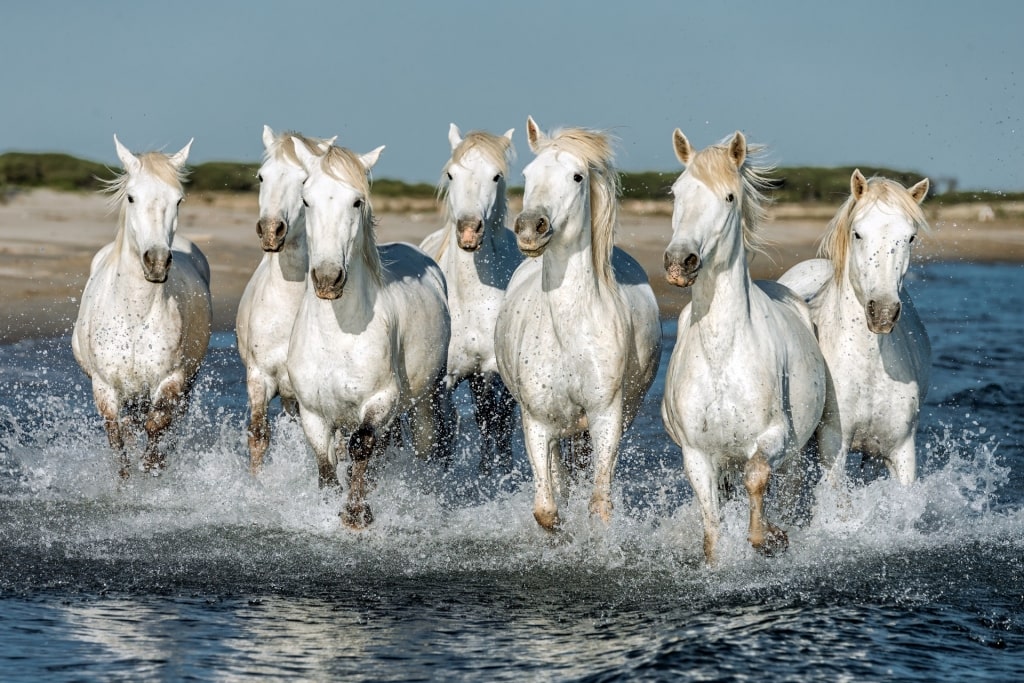
White horses in Camargue
This national park is famous for its salt production, white horses, and flocks of pink flamingos. Essentially the delta for the Rhône River, this vast wetland is an ornithological paradise.
In Aigues-Mortes, it’s possible to arrange a 4×4 tour of the national park. You’ll see storks nesting in stone towers, flamingos dredging the lagoons with their beaks, and the curious sight of white egrets perching on the backs of the famous salt-white horses.
Read: Majestic Walled Cities in France to Explore
Bandol
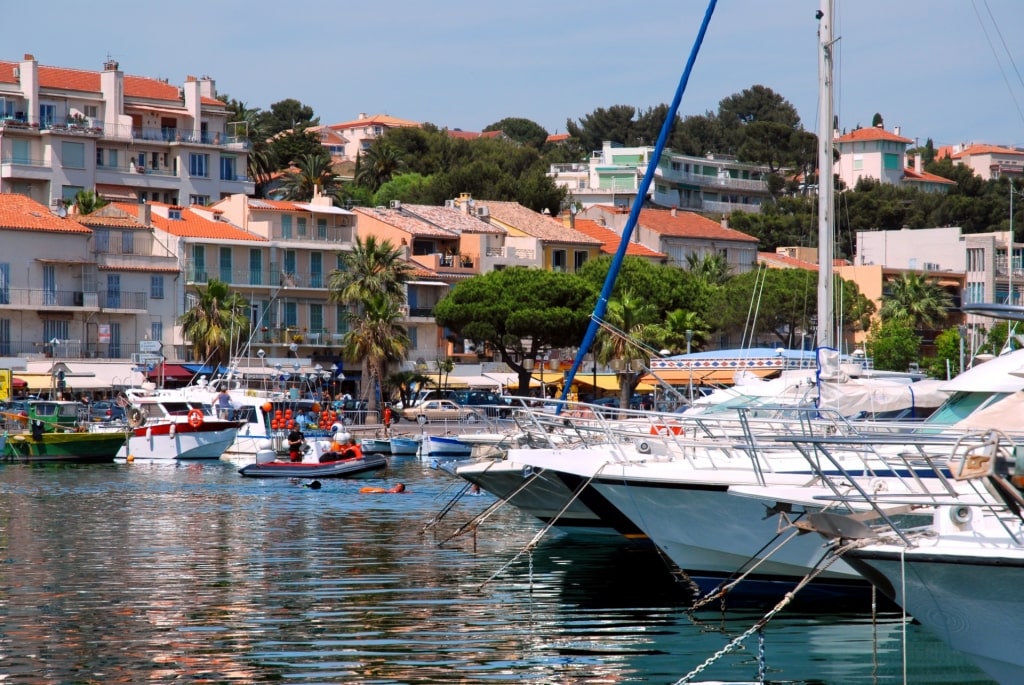
Bandol
Bandol’s unique synthesis of a vivacious seaside resort with a heavyweight wine region makes it one of the best small towns in France to visit.
Just a short hop from Toulon, the French beach town was the prototypical glitzy resort before Saint-Tropez, with visitors like Aldous Huxley and Thomas Mann browsing its boutiques and choosing between the plethora of sand or pebbled beaches.
Today, the Ronald-Fream-designed Fregate golf course sits in the hills, its long tongues of green washed by sea breezes and lined with bushy pines.
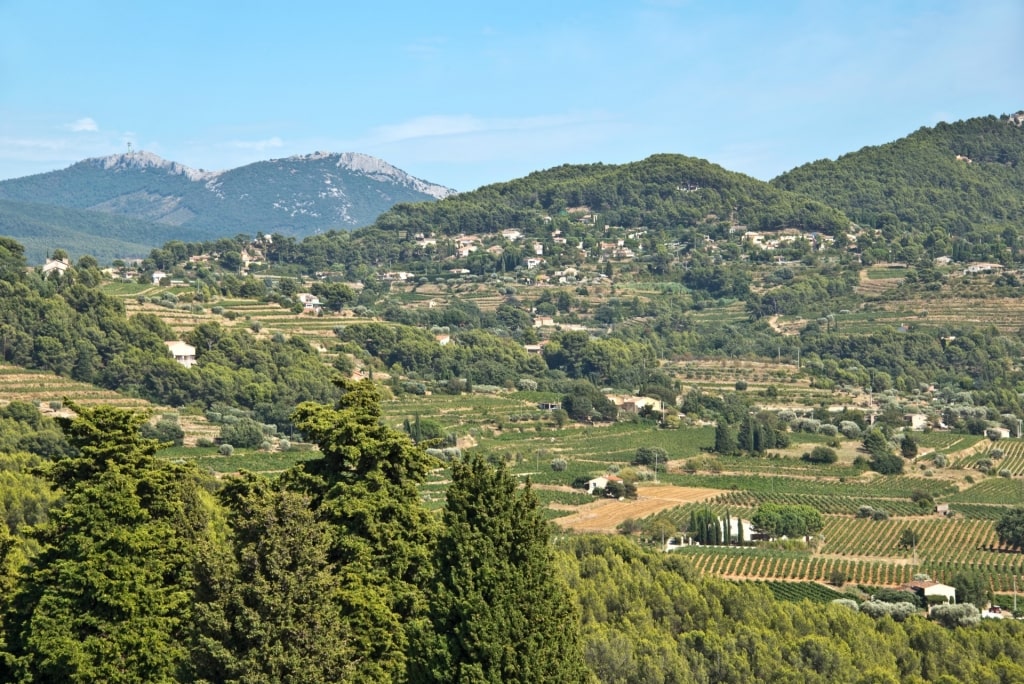
Bandol wine region
The region obtained its AOC designation in 1941 and Bandol’s rosé wines are considered some of the best in France. Sit and drink a chilled glass on the crimson seats of Bar Le Winny while watching the jet skis, paddle boarders, and kayakers tackling the waves on the busy main beach.
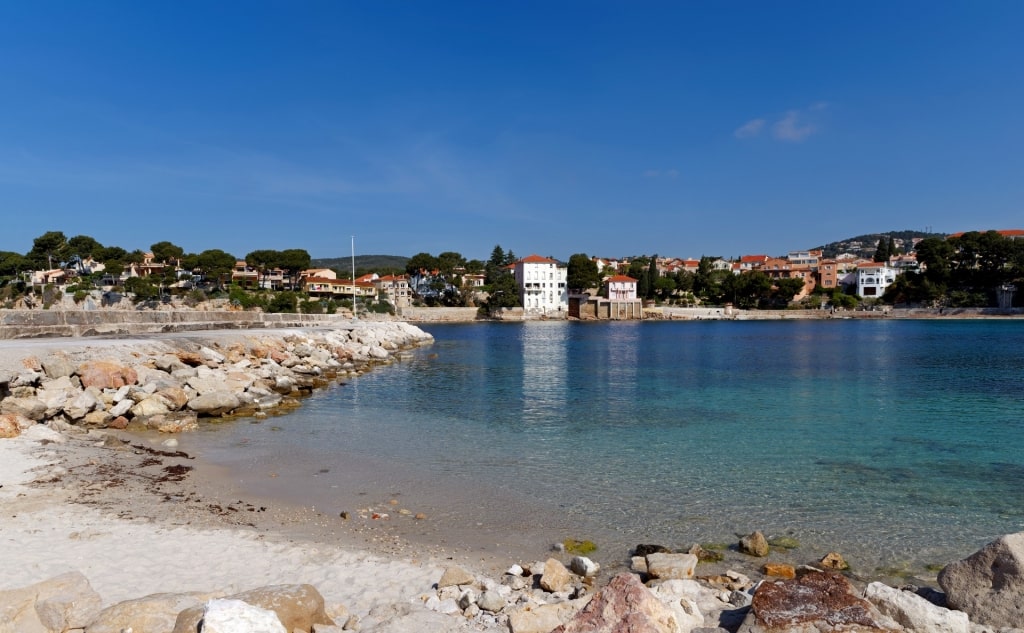
Renecros Beach, Bandol
In a westerly direction, make your way past the marina to find the quieter, boat-free Renecros Beach. Its glassy shallows are ideal for snorkeling within this sheltered cove.
Les Baux-de-Provence
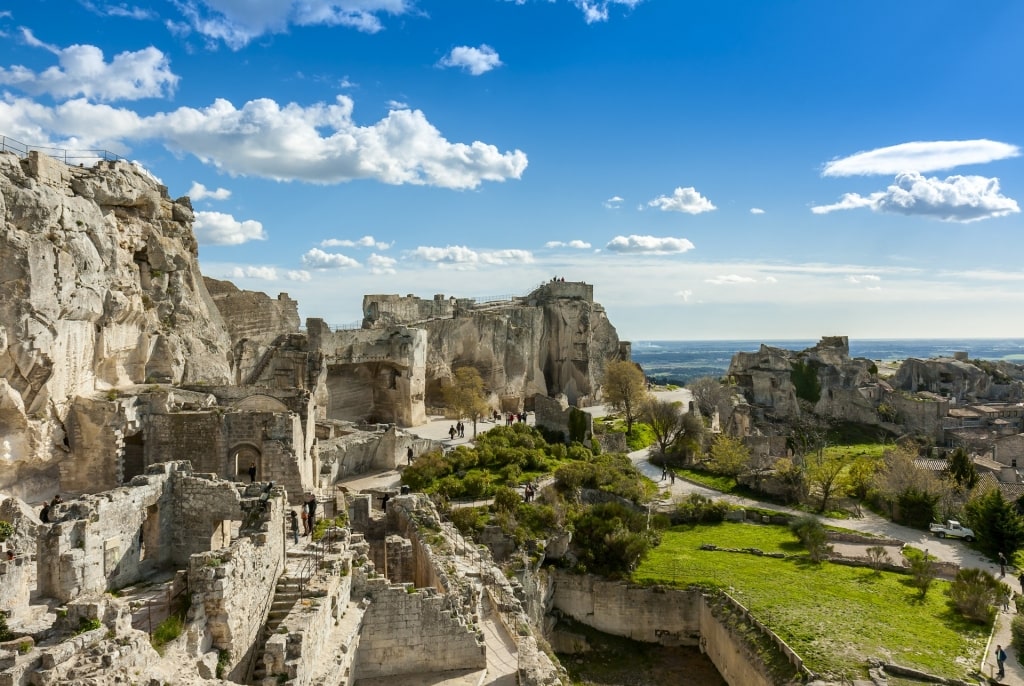
Les Baux-de-Provence
This former medieval stronghold-turned-quintessential Provençal village is a remarkable sight, the jumble of terracotta houses enclosed within the muscular embrace of a mountain.
Above it sits a medieval fortress, with aspects that reach as far as the Camargue, Arles, and the surrounding Alpilles range.
About half an hour northeast of Arles, this unique town—officially designated as one of France’s most beautiful—is part open-air museum, part ruin. But it’s far from lifeless—the summer sees a program of historical events that help bring the history to vivid life.
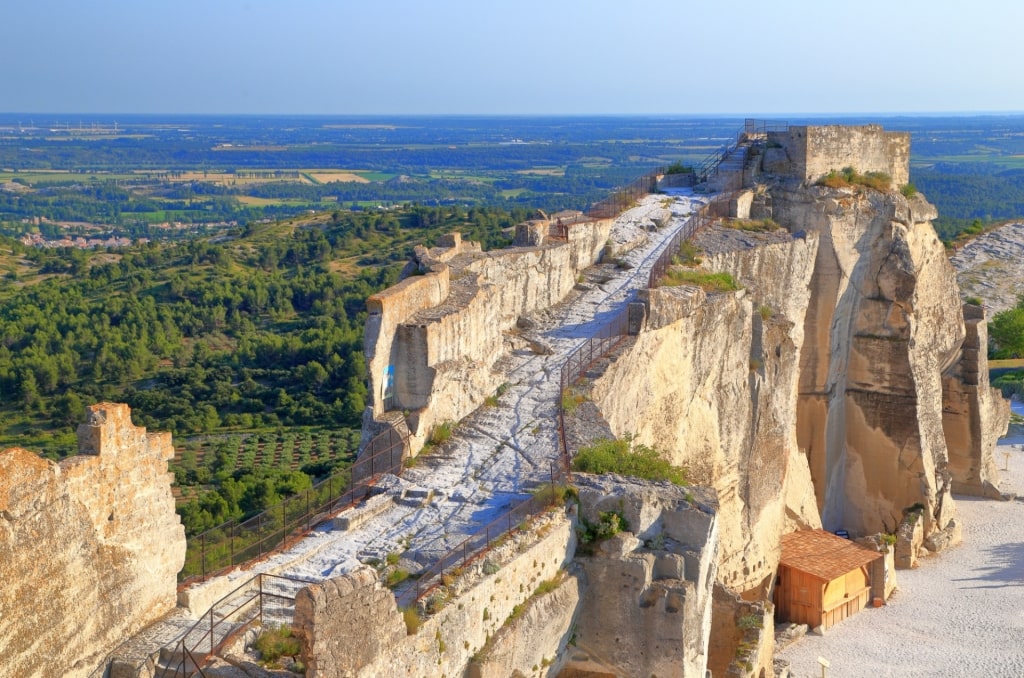
Les Baux-de-Provence
A visit to the fortress is also essential. On the rocky spur of Les Baux, the Château des Baux was of major strategic importance in the region, with its near impregnable situation.
Within you’ll find reconstructions of trebuchets, the kind of siege weapon that would have been rolled up beneath the town with destructive intent. Fortunately, Les Baux-de-Provence endured.
Read: Famous Historical Sites in France
Saint Tropez
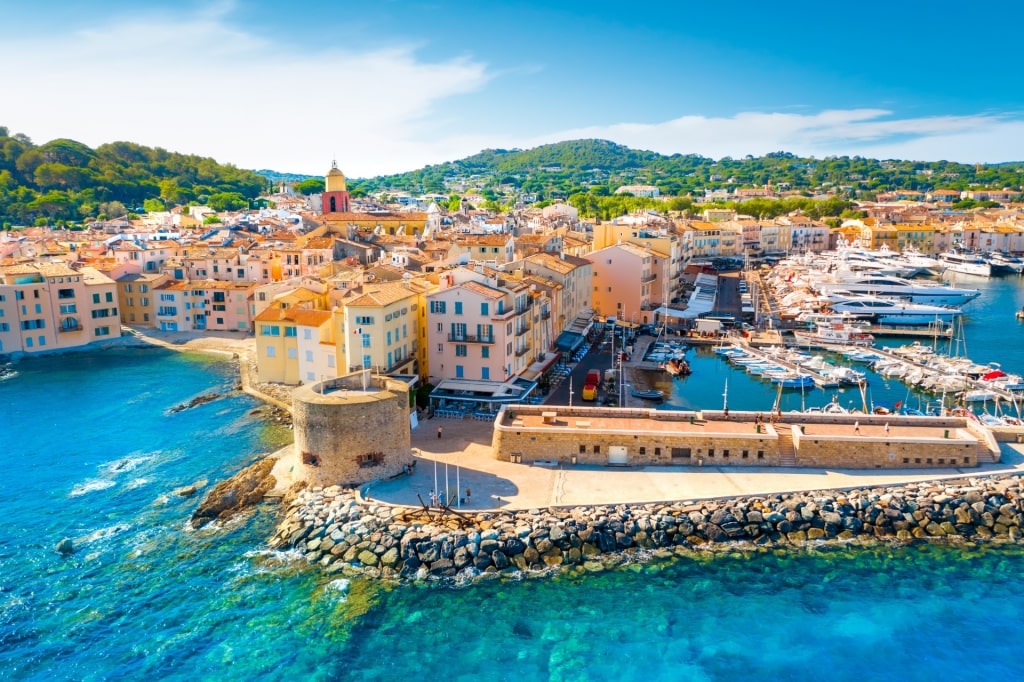
Saint Tropez
Ever since Brigitte Bardot put Saint Tropez on the map in the late 1950s, the town has been synonymous with sun-splashed Côte d’Azur glamor. Despite this, it remains recognizably Provençal; if the wind is right, the whiff from the traditional fish market pursues you into the air-conditioned cool of the Bulgari boutique.
There’s more to this pretty pastel fishing village than yachts, beaches, and Vieux Port waterside tables with silver forks glinting as they dip into sugar-dusted slices of Tarte Tropézienne.
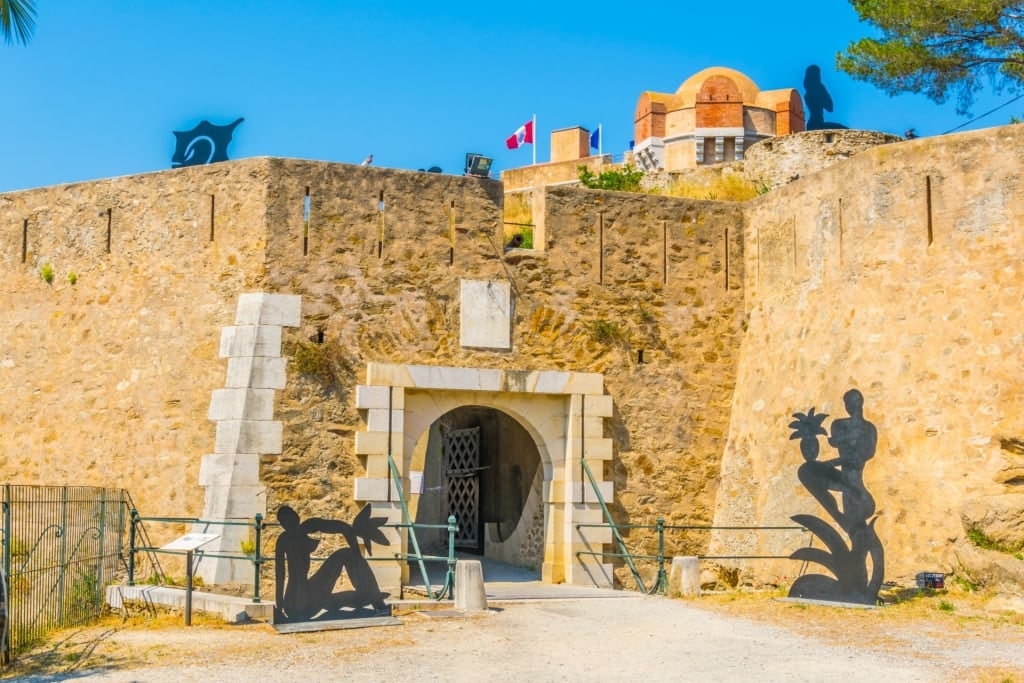
The Citadel & Museum of Maritime History, Saint Tropez
Particularly worth a visit is The Citadel & Museum of Maritime History, a 17th-century fortress with gardens. Tour its naval museum, set atmospherically in the dungeons.
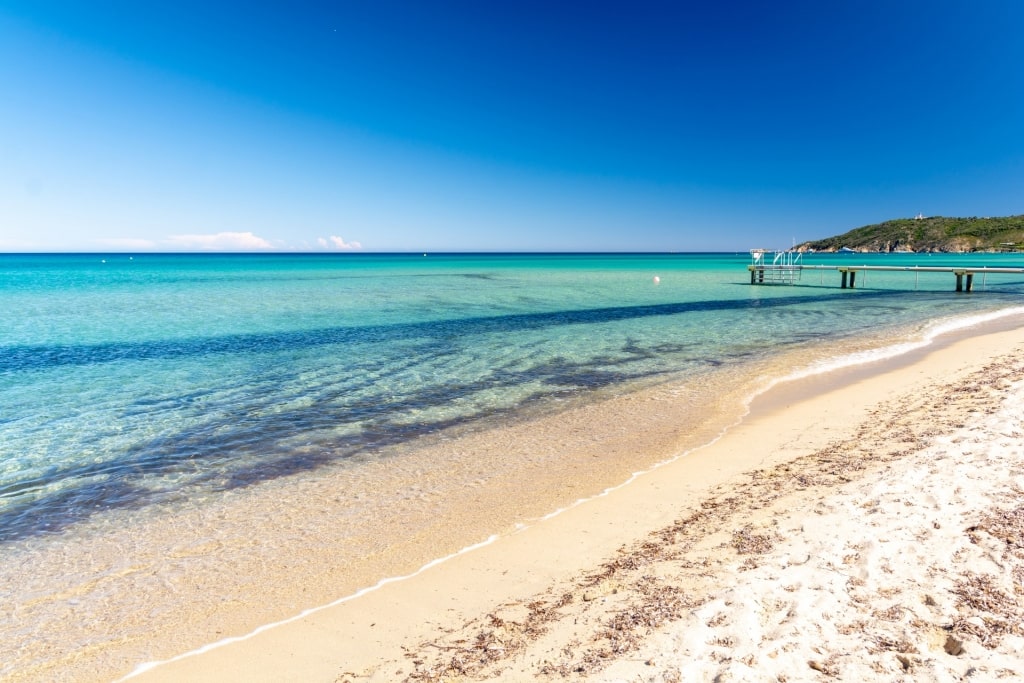
Pampelonne Beach, Saint Tropez
Of course, you’ll also want to see Pampelonne Beach—the busy swathe of silken sand where Bardot—now a Saint Tropez resident—filmed her famous scenes. Stop in for some refreshment at Club 55, the starry dinner shack on the beach, which was originally built to house the film’s production team.
Read: Best Places to Go Shopping in France
Gordes
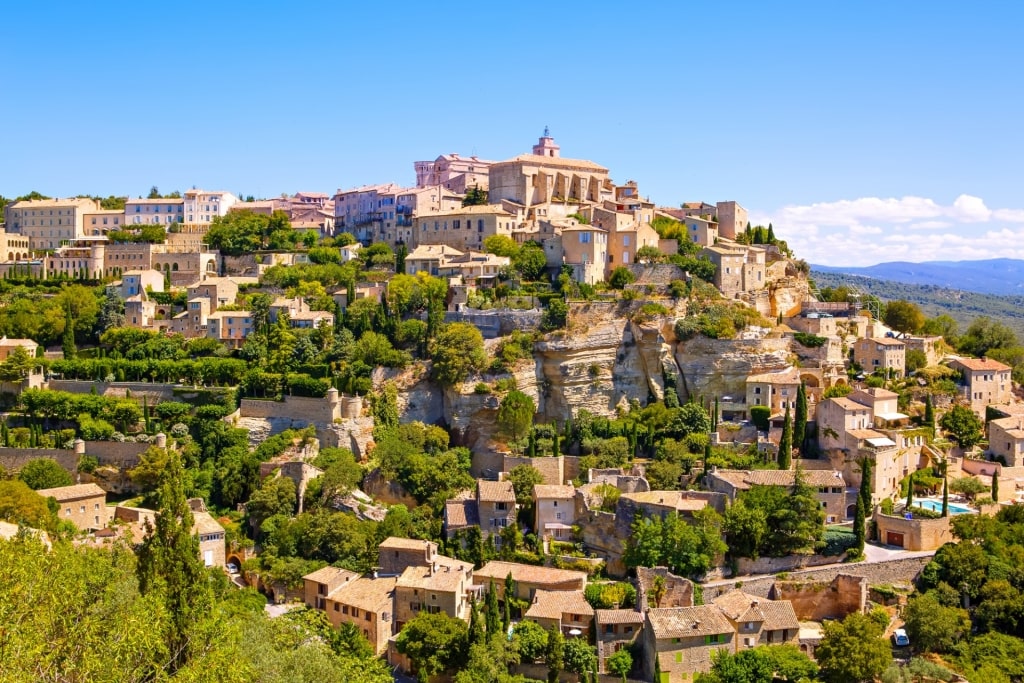
Gordes
Provence challenges Tuscany for its density of stunning hill towns, with the terracotta roofs rising amid cypress spires and the bottle-green cumulus of the pine forest.
That Gordes is frequently picked out as one of the finest examples of these points to how essential it is that you discover its weathered charms first hand.
Half an hour’s drive east of Avignon, and situated amid the foothills of the Vaucluse Mountains, Gordes was a favorite with artists including Marc Chagall, André Lhote, and Pol Mara, who actually stayed here.
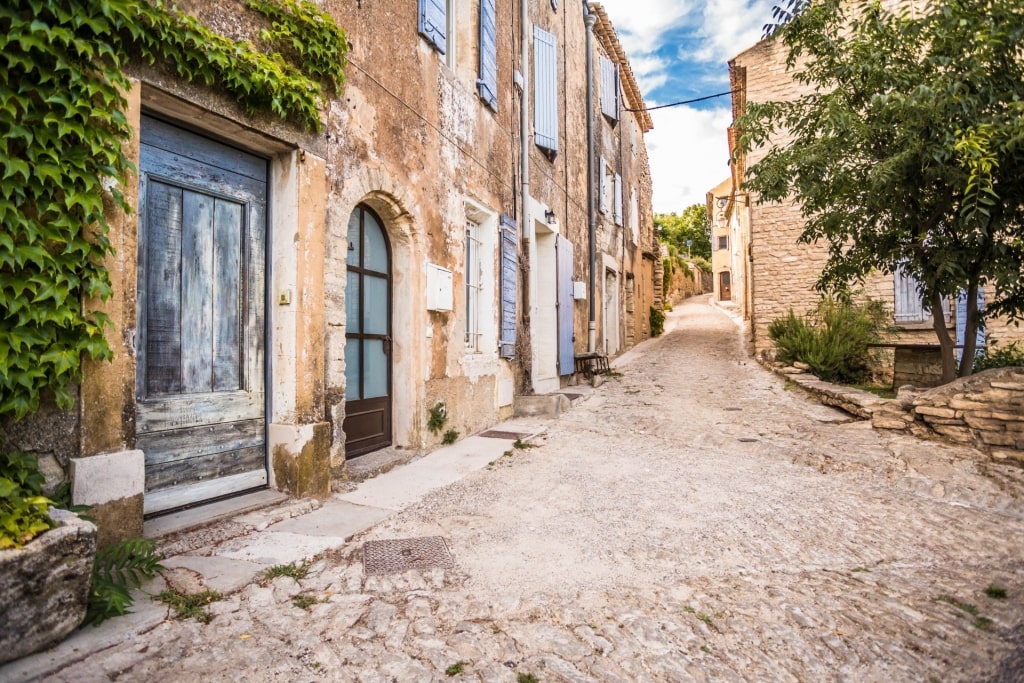
Gordes
These artists had a good eye for scenic and architectural harmony, which is exactly what you’ll find on the calades (narrow cobbled streets) of Gordes as you navigate the mazy old town.
Water trickles from stone fountains in squares dappled with shade while locals converse over drinks, the faded white of the café umbrellas a close match for the local stone.
If you can pull yourself away from the timeless squares, take time to see the town’s chateau, renovated during the renaissance, but dating back to the 10th century. Within its magisterial proportions, you’ll find a museum dedicated to the vivacious art of the Flemish pop artist, Pol Mara.
Read: Extraordinary Castles in France
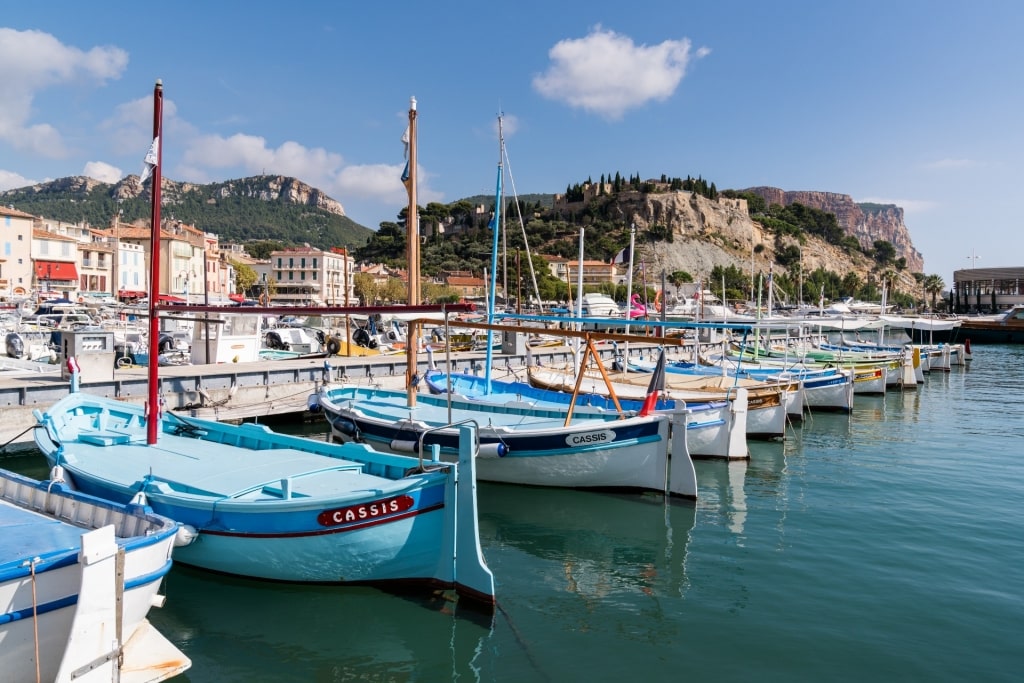
Cassis
Discover the best small towns in France on a cruise to this historic European country, from honey-stone Provençal villages to the colorful facades of Honfleur in the north. Browse Celebrity’s cruises to France and book an unforgettable vacation.
